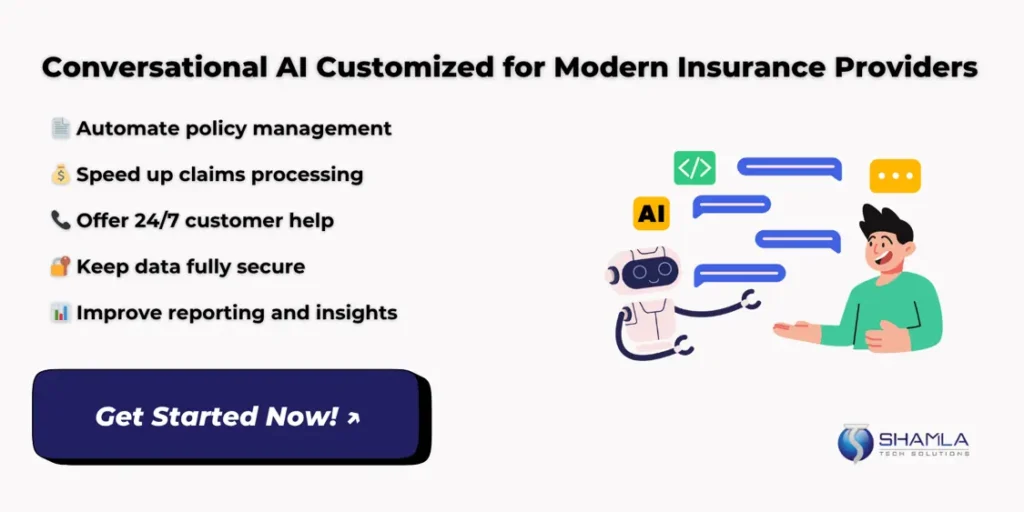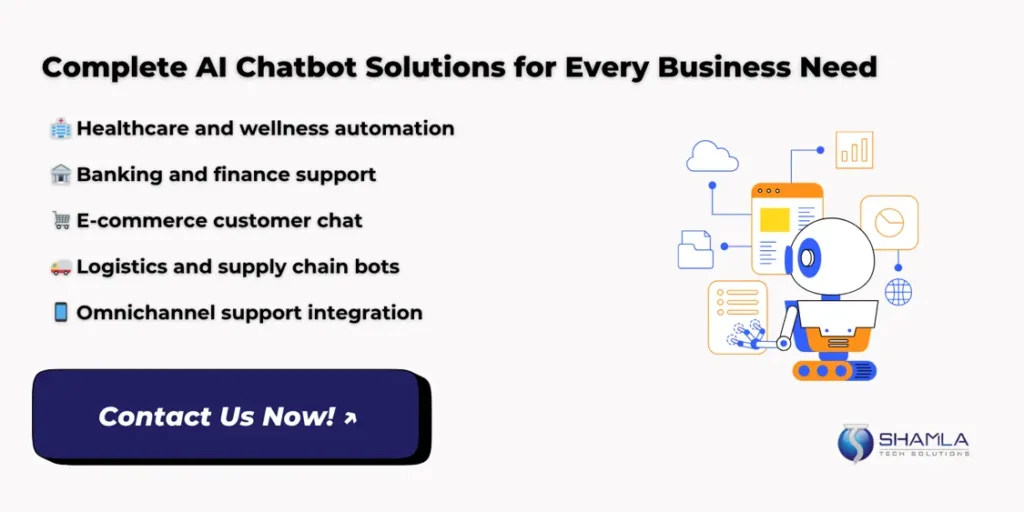Automated claim start saves time and cuts errors. Users open policies with simple questions. The agent parses details and uploads forms. conversational AI for insurance guides customers easily without waiting. AI chatbots in insurance check coverage, validate documents, and flag missing items. This reduces manual review and speeds rapid payout. Customers see real status updates instantly. The system learns from past claims to improve true accuracy. Overall, benefits of conversational AI include faster service, fewer mistakes, and boosted user confidence.
Insurers use conversational AI in insurance to offer nonstop help for policyholders. Systems handle billing questions, coverage details, and plan changes at any hour. Simple text or voice chats let users get quick answers. AI chatbots in insurance manage multiple sessions, ensuring no caller waits. Automated workflows pull data from policy databases, spot gaps, and send alerts. The service adapts to each user profile and logs each interaction and delivers personalized guidance. This builds trust and cuts call center load.
Agents deploy conversational AI for insurance to drive lead capture on websites and apps. Interactive forms ask qualification questions and gather contact details automatically. Then AI systems score prospects based on answers and route hot leads to sales teams. Conversational AI in insurance handles welcome messages and guides new clients through signup. AI chatbots in insurance verify identity, explain plan options, and collect digital signatures. This cuts manual outreach and speeds client activation. Improves conversion rates and lowers acquisition expenses.
Insurers use AI to catch fraud by spotting odd claim patterns fast. conversational AI in insurance monitors text and voice interactions to flag mismatches. The system checks responses against policy history and payment records. When it finds risk signs, it sends alerts to fraud teams. This lets staff review issues before payouts. Benefits of conversational AI include sharper detection and fewer false alarms. Learning updates rules, so alerts get smarter. The result is lower fraud losses and better claim integrity.
Insurance firms deliver tailored plan suggestions using customer data. They analyze profiles, claim history, and risk scores in real time. Conversational AI for insurance runs these checks as users chat, matching products to needs. The chatbot asks follow-up questions and refines options quickly. It can show side-by-side features and pricing. This feedback boosts purchase rates. Data from these interactions train models to improve future suggestions. As a result, customers get plans that fit their lives and firms see higher conversion.
Automating routine tasks cuts staff hours and lowers expenses. Conversational AI for insurance routes user requests, fills forms, and updates records without human input. Systems integrate with policy databases and RPA tools to trigger workflows instantly. AI chatbots in insurance use natural language parsing to capture data and validate entries. This removes manual steps and shrinks processing time. As a result, teams handle more volume with the same headcount. Finally, the benefits of conversational AI include clear audit trails and predictable operating costs.
Automated claims engines speed review and payout. Conversational AI in insurance parses incident details and applies rule sets instantly. Chat interfaces guide users to upload evidence and confirm policy terms. AI chatbots in insurance validate documents against coverage rules and flag exceptions for human review. This cuts cycle time and raises customer satisfaction scores by delivering answers in minutes. The benefits of conversational AI show in real-time status updates and reduced call volumes, leading to better feedback and stronger trust.
Handling surges without extra staff boosts capacity. Conversational AI for insurance scales chat loads across channels like web, mobile, and voice, without performance drops. Bots use intent detection to route complex queries to specialists and resolve routine issues automatically. Conversational AI in insurance adapts to peak seasons and sudden events without lag. This ensures constant uptime and consistent response quality. Teams focus on high-value tasks while bots cover FAQs and simple requests. Overall, AI chatbots in insurance deliver reliable service under any demand.
Accurate risk assessment needs rich user data. Conversational AI in insurance guides applicants through structured interviews, capturing details like assets, health factors, and coverage history. AI chatbots in insurance validate inputs, detect inconsistencies, and prompt clarifications in real time. Data feeds into underwriting models to improve risk scoring and pricing accuracy. The benefits of conversational AI include standardized data formats and fewer manual checks. Insurers gain clearer insights faster, reducing underwriting backlog and improving portfolio performance.
Serving varied markets demands language flexibility. Conversational AI for insurance offers built-in translation and regional dialect support in chat and voice channels. Bots detect user locale and adapt prompts, terminology, and compliance messages accordingly. This ensures clear, accurate guidance across languages and cultures. As global firms expand, AI chatbots in insurance maintain consistent service without hiring native speakers. The benefits of conversational AI include broader reach, higher engagement, and lower localization costs—all driven by smart language models.
Automated policy renewals use chatbots to prompt customers before expiration. conversational AI for insurance sends renewal alerts, verifies payment details, and processes transactions. The system links with billing engines and policy databases to complete renewals without agent input. It then issues email summaries and receipts instantly. Benefits of conversational AI include higher retention rates and fewer policy lapses. The model learns optimal timing through past response data. Insurers see reduced churn, faster, more accurate revenue recognition, and improved cash flow.
Instant claim status updates keep customers informed. AI chatbots in insurance pull data from claim systems and provide round-the-clock notifications. The bot reads case IDs, checks workflow stages, and sends clear progress messages via SMS or chat. It uses checks to detect delays and directly pushes alerts for human intervention. This feature frees staff to focus on complex tasks. benefits of conversational AI include higher transparency and fewer inquiry calls. Overall, claim experience improves and trust grows with this tool.
Voice-enabled customer interactions let users speak queries. conversational AI in insurance uses speech-to-text and natural language parsing to handle calls without delay. The system recognizes intents for billing, coverage checks, and claim filings. It routes complex requests to live agents with summaries. Voice bots also follow compliance scripts and record interactions. This approach reduces hold times and boosts satisfaction. Benefits of conversational AI include instant access and improved accessibility. Insurers deploy these bots in contact centers to scale voice support.
Cross-channel integration connects chat, email, SMS, and voice into one workflow. conversational AI in insurance syncs conversations across platforms, users switch channels smoothly. The system stores session data and user preferences centrally. When a user moves from web chat to mobile app, the bot recalls past context and continues the interaction. Agents see unified records and join conversations if needed. This reduces repeated questions and streamlines support. Integration also logs data into CRM systems and analytics dashboards for performance tracking.
Post-sale feedback collection uses chat surveys to capture customer opinions. AI chatbots in insurance send targeted questions after key events like renewals or claims. conversational AI for insurance analyzes responses to spot satisfaction scores and service issues. The system asks ratings and open comments through chat or email links. Data feeds into BI platforms for trend analysis and agent performance reviews. Alerts trigger follow-up actions when low scores appear. This real-time loop helps firms address problems fast and refine processes.
Conversational AI in insurance uses TLS for data in transit and AES for stored records. Role-based controls and token expiration guard access. Audit logs track every event for compliance tracking.
AI chatbots in insurance record timestamped transcripts, user intents, and system responses. Structured logs link each interaction to user sessions. Monitoring dashboards surface error rates and performance metrics for troubleshooting.
AI chatbots in insurance enforce consent capture and apply data retention policies. They embed rules in chat flows and flag violations. Audit logs generate reports for regulators and show compliance.
Conversational AI in insurance uses session tokens to track dialogue. User inputs link to context objects in memory. Bots reference recent exchanges to grasp intent. Context resets after idle periods.
AI chatbots in insurance send events to analytics pipelines. Systems track intent counts, response times, and resolution rates. Dashboards show trends. Teams use detailed reports to tune models, boosting performance.





